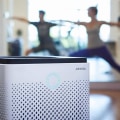Air purifiers are a great way to improve the air quality in your home, but do they work through walls? The answer is no. Air purifiers cannot go through walls, corners, hallways, or flights of stairs to clean the air in a living room or work room. However, they can be used to clean the air in each room of your home. The best location for an air purifier is on the wall.
To hang it on the wall, you have to raise it and secure it in the same way you would hang a picture. Most modern air purifiers are easy to move from room to room, so you can move them as needed, making sure you use the best one for each room. Air purifiers are most effective when all doors and windows are closed. This allows the air cleaner to clean the air in the room without interference from hallways or other rooms.
If the doors are not fully closed, air will flow wherever there is an opening and the air cleaner will attempt to extract air from the outside. This can be counterproductive, as small particles such as dust and pollen can enter the room and create a carpet of particles that won't go away. During the summer, when temperatures can rise to three digits, placing the air purifier near an open window can trap some particles as they enter the room. However, make sure you find a safe place for your air purifier so it doesn't get damaged by extreme heat.
Air purifiers work by sucking contaminated air into the system before releasing clean air. Clutter, large furniture, or debris can block this process and reduce its effectiveness. A wall unit won't have these problems. Most air purifiers contain filters that capture airborne contaminants such as dust, smoke, pollen, pet dander, mold and mold spores, bacteria and viruses, volatile organic compounds (VOCs), and other particles as small as 0.3 microns.
Some also have ultraviolet filters that use light to destroy biological impurities such as mold and bacteria. If mold becomes a problem in your home, an air purifier that removes particles from the air may be a good option since mold spores are large enough to be captured even with non-HEPA filters. You may also want to consider getting an activated carbon filter to remove odors and airborne chemicals from your home. You don't need to buy a separate air purifier for each room in your house; however, if you want to ensure clean air in every room of your house no matter how much space your air purifier covers, it's best to buy one for each room.
You can also get HEPA air purifiers that manage 3000 square feet and these will work well if you place them in every room of a smaller house. When using an air purifier, make sure you keep it away from areas of moisture such as steam-filled bathrooms as filters inside an air purifier can absorb moisture and reduce their lifespan. To sum up, an air purifier cannot go through walls but it can be used to clean the air in each room of your home. Make sure you buy one for each room if you want to ensure clean air throughout your house and keep it away from areas of moisture for optimal performance.







